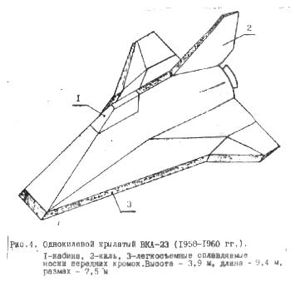
Home - Search - Browse - Alphabetic Index: 0- 1- 2- 3- 4- 5- 6- 7- 8- 9
A- B- C- D- E- F- G- H- I- J- K- L- M- N- O- P- Q- R- S- T- U- V- W- X- Y- Z
Buran M-48
 VKA-23 1959 VKA-23 Design Alternate 1. M-48 configuration that preceded it is believed to have been a similar faceted design. |
AKA: M-48. Status: Study 1958. Thrust: 15.60 kN (3,507 lbf). Gross mass: 4,500 kg (9,900 lb). Unfuelled mass: 4,300 kg (9,400 lb).
Some of the detailed goals were met in the 1960's by development of triple-sonic fighters and bombers, such as the MiG-25 and Sukhoi T-4. However a more ambitious objective was investigation of hypersonic vehicles. This was to be conducted in a two phase program. Phase One would take an experimental vehicle up to 6,000 to 7,000 km/hour at altitudes of 80 to 100 km. In this phase the vehicle would remain controllable using aerodynamic surfaces. Phase Two would take the vehicle to Mach 10, and 100 to 150 km altitude. This would require solving problems of control at hypersonic speeds, reaction control of the vehicle outside of the atmosphere, re-entry, and landing.
An official government resolution permitting development of the M-48 spaceplane was officially issued in December 1959. Contact between the Myasishchev and Korolev bureaus in solving the problems remained close. In March 1960 L L Selyakov (assistant to Myasishchev for project work) and G D Dermichev (chief of the project section) were assigned to the M-48. Refined calculations indicated that the R-7 could loft a 4.5 metric ton vehicle to 400 km suborbital trajectory and a 4.0 metric ton vehicle to 500 km. 40 percent of the VKA's exterior surface would have to be covered with heat shielding. A 1600 kgf braking engine would provide 150 m/s of maneuvering capability. In suborbital tests, the engine would extend the range of the VKA by 200 km or by 100 km laterally from a strict ballistic trajectory.
The flight characteristics of the VKA were confirmed independently by the Soviet Academy of Sciences and its head, M V Keldysh. It was calculated that a hypersonic lift to drag ratio of 0.25 to 0.30 would be achieved in ballistic re-entry of the vehicle. This was essentially the same as the optimum lifting ballistic shape, the 'headlamp' Soyuz shape. But the shape of the VKA meant non-uniform heating and the need to maintain a high angle of attack. The recommended re-entry profile consisted of a ballistic re-entry to 30 to 40 km altitude, where the spacecraft would transition to a maneuvering entry by the use of extendible shielded wings. The hermetically sealed cabin provide accommodation for two crew in encapsulated angled ejection seats.
The draft project proposal was reviewed by the expert commission in April 1960. K P Ostinin suggested an alternative vehicle, using deployable rotors of 8 m for vertical landing (not knowing that Myasishchev had studied and rejected such schemes using rotors of 12 m and 16 m diameter). V V Struminskiy believed that the transition to winged flight could not be commenced as early as Myasishchev thought, and that a ballistic trajectory should be flown until subsonic speed was attained. S P Srishcherian believed that the configuration would have insoluble thermal control problems due to its many hot spots, and that the extendible wings would require an excessive amount of thermal protection compared to a simpler fixed wing design. V A Dzhapridze and A I Makarevskiy questioned the '48' design on many points. Makarevskiy believed the program would require extensive preliminary testing of a full-scale test bed, where the wings could be fixed and tested at various angles.
It was clear that many technical problems had to be cleared incrementally before an operational vehicle could be fielded. Myasishchev's team went 'back to the drawing board', the result being two alternative single-crew orbital spaceplanes (see VKA-23 Design 1 and VKA-23 Design 2).
Crew Size: 2. Habitable Volume: 2.00 m3. Spacecraft delta v: 150 m/s (490 ft/sec).
Family: Spaceplane. Country: Russia. Agency: Myasishchev bureau. Bibliography: 192, 81, 83.
1958 During the Year - .
- Soviet Air Force requested development of high-speed aerospace vehicles. - .
Nation: Russia.
Spacecraft: Buran M-48.
Phase One would take an experimental vehicle up to 6,000 to 7,000 km/hour at altitudes of 80 to 100 km. In this phase the vehicle would remain controllable using aerodynamic surfaces. Phase Two would take the vehicle to Mach 10, and 100 to 150 km altitude. This would require solving problems of control at hypersonic speeds, reaction control of the vehicle outside of the atmosphere, re-entry, and landing.
1959 December - .
- Official government resolution permitting development of the M-48 spaceplane. - . Nation: Russia. Spacecraft: Buran M-48. An R-7 would loft the 4.5 tonne VKA vehicle to 400 km suborbital trajectory..
1960 April - .
- M-48 spaceplane draft project reviewed by expert commission. - .
Nation: Russia.
Related Persons: Myasishchev.
Spacecraft: Buran M-48.
It was clear that many technical problems had to be cleared incrementally before an operational vehicle could be fielded. Myasishchev's team went 'back to the drawing board', the result being two alternative single-crew orbital spaceplanes (VKA-23 Design 1 and VKA-23 Design 2).
Back to top of page
Home - Search - Browse - Alphabetic Index: 0- 1- 2- 3- 4- 5- 6- 7- 8- 9
A- B- C- D- E- F- G- H- I- J- K- L- M- N- O- P- Q- R- S- T- U- V- W- X- Y- Z
© 1997-2019 Mark Wade - Contact
© / Conditions for Use